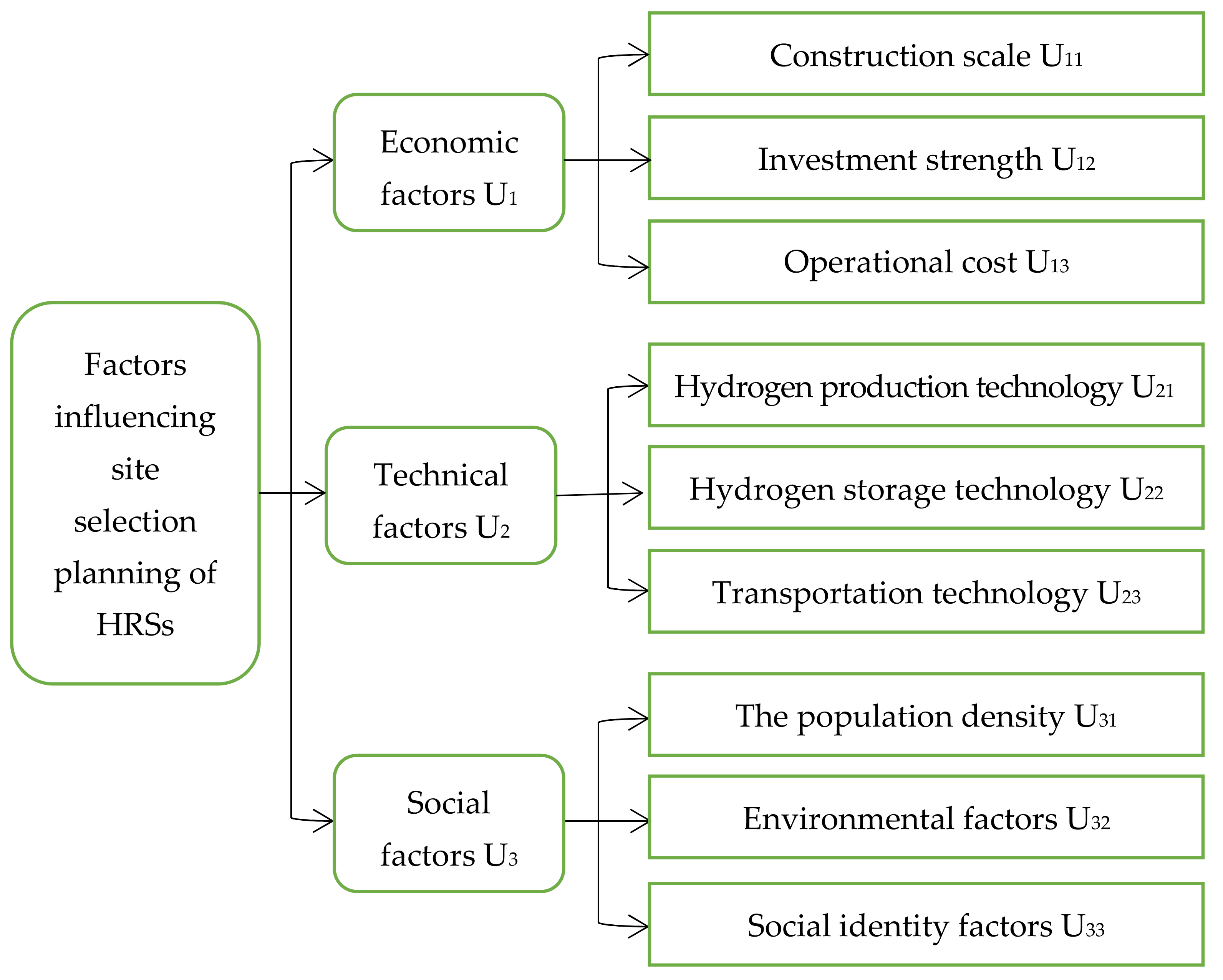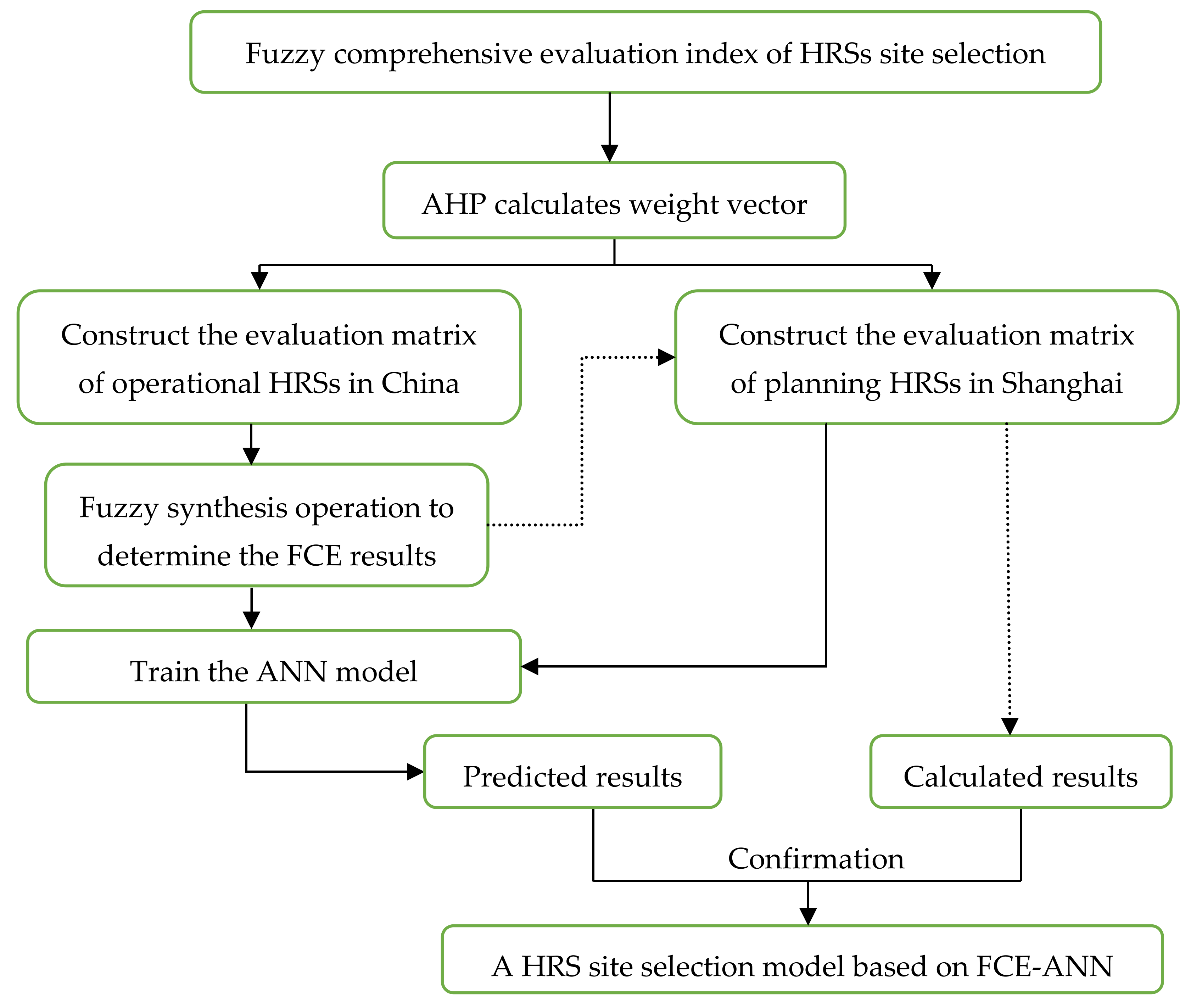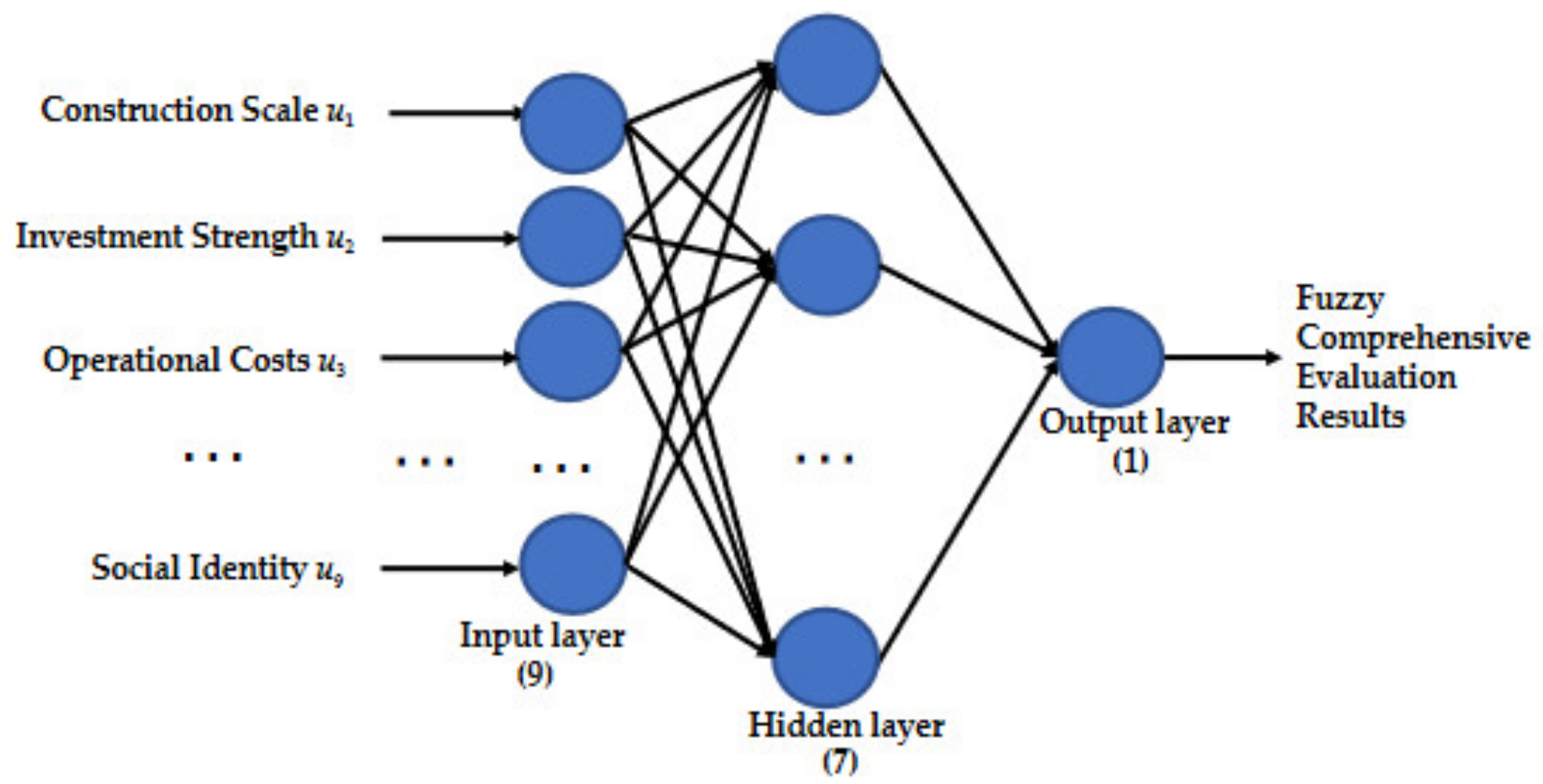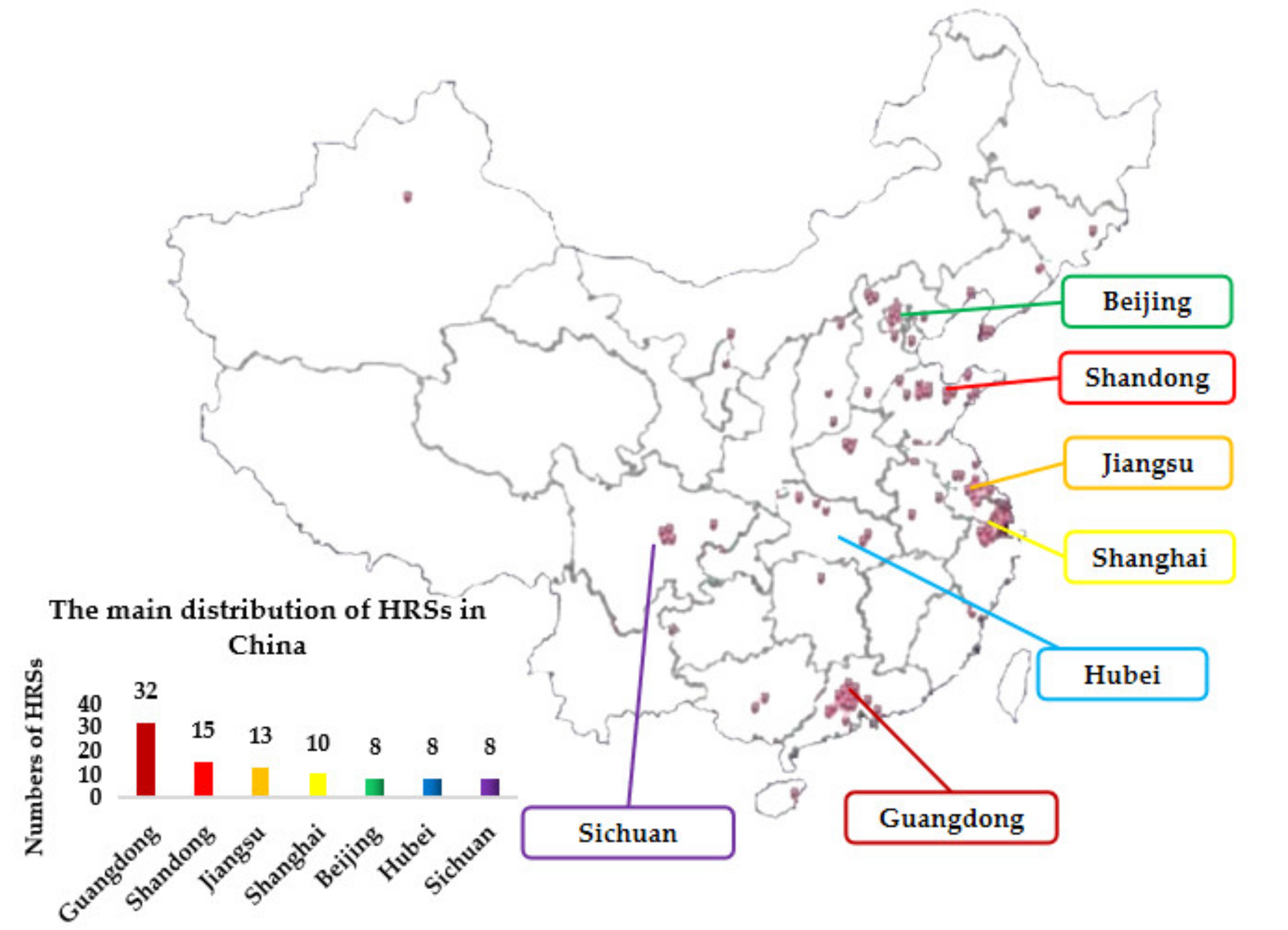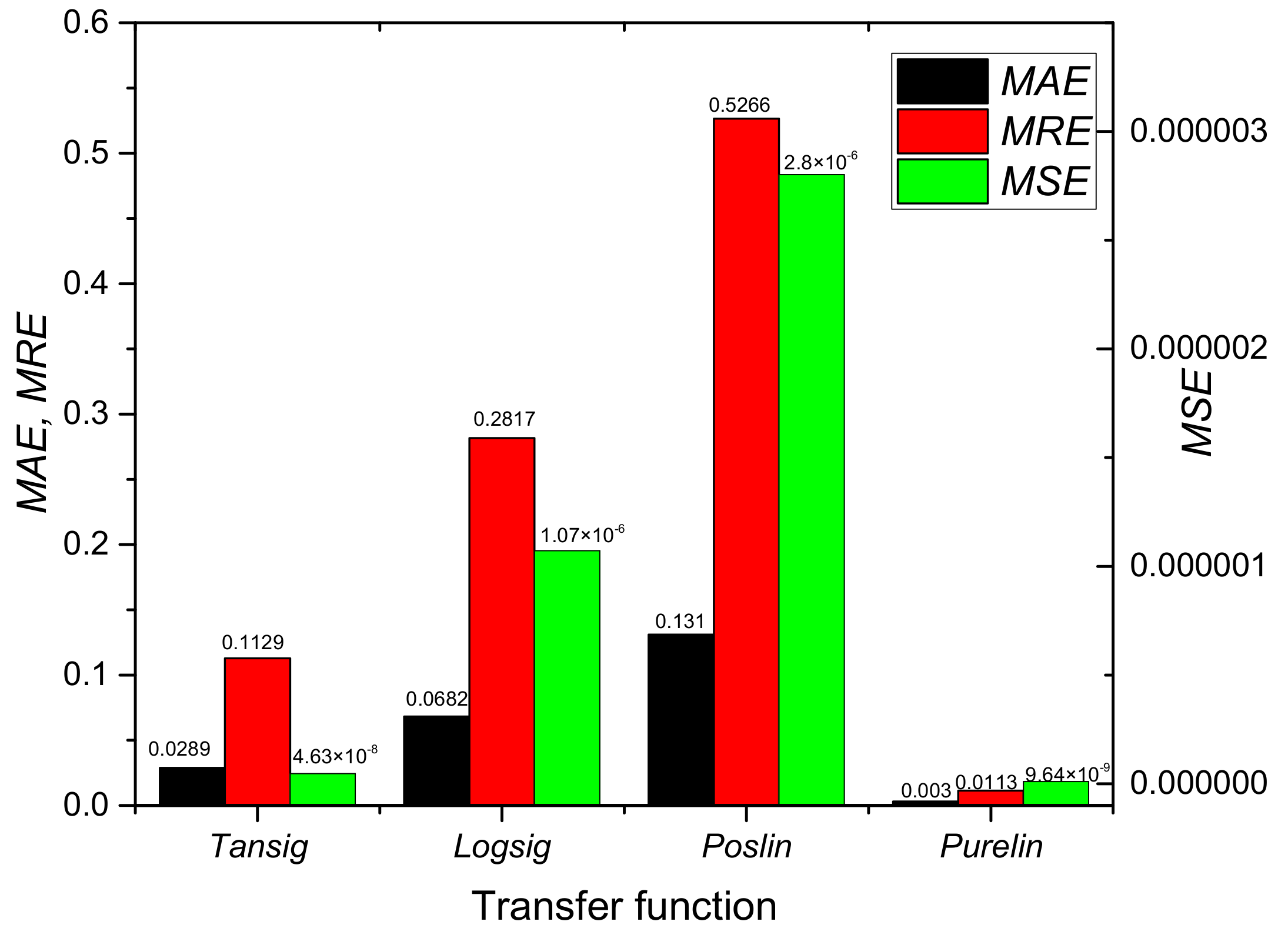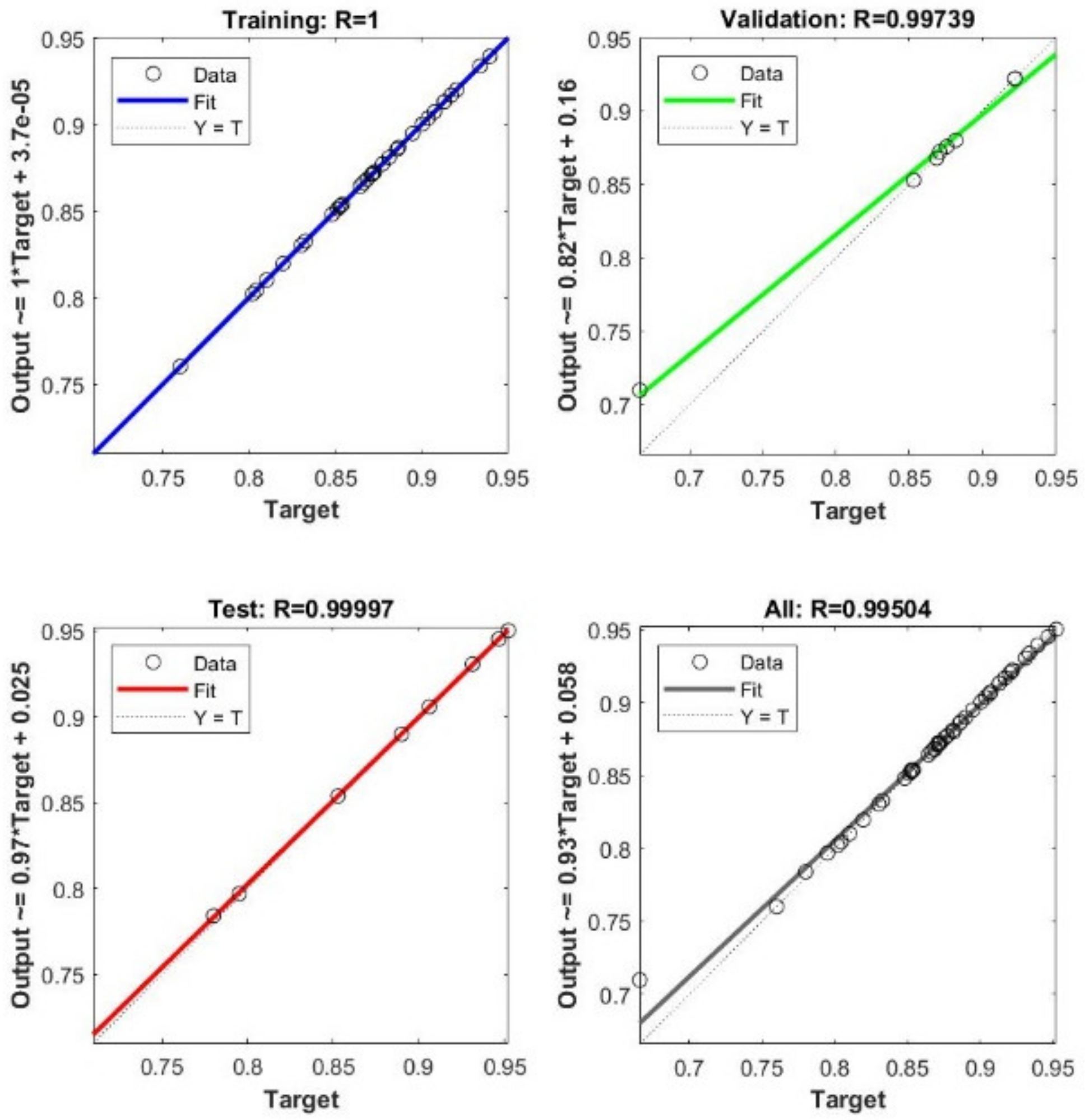1. Introduction
Hydrogen energy is known as the cleanest secondary energy, and hydrogen fuel cell vehicles (HFCVs) have attracted much attention due to their near-zero emission and pollution-free advantages [
1,
2]. Hydrogen fuel cell vehicles can be used efficiently and conveniently, and rationally set HRSs play a key role [
3,
4]. The site selection of HRSs involves the influence of various factors such as technology, economy and society. For a long time, establishing scientific and reasonable site selection criteria has been a problem academic circles are striving to solve [
5,
6]. In the past five years, various countries have begun to build HRSs on a large scale to promote the development of the HFCVs industry [
1,
7,
8,
9]. According to statistics, the number of HRSs in the world has exceeded 900, of which more than 300 are in China. Also, there were more than 500 HRSs in operation in the world by the end of 2021 [
10,
11].
Figure 1 shows the operation, construction and planning of HRSs in China and around the world. As can be seen from
Figure 1, compared with the world, China has a relatively small proportion in normal operation and a large proportion in planning. As the largest country in the production and sales of new energy vehicles, relevant institutions and enterprises highly value site selection [
12]. However, the HRS layout and planning are not simple. There are many factors and obstacles to consider, such as high construction costs, immature hydrogen transportation technology, long payback periods, and a shortage of HFCVs [
5,
13,
14,
15]. These obstacles lead to the actual operation of HRSs not being positive. Compared with gas stations, HRSs have greater safety risks; the recent HRS explosion in Norway confirmed this [
16]. Especially in a city, and faced with a relatively dense population and complex and specific road environments, factories, and other building facilities, the construction of hydrogen refueling stations is more difficult [
17,
18]. The motivation of this research is to seek to establish an intelligent decision-making model for the site selection of HRSs, which specifically guides the location and construction of HRSs, so as to promote the rapid development of the hydrogen fuel cell vehicle industry. The relevant results are verified in Shanghai, China.
It has been found according to previous studies that many scholars have begun to carry out related research on HRSs. In order to solve different problems, the research themes are also different. For example, on the issue of factors affecting the construction of HRSs, Xu, C. et al, focusing on the obstacles in the development of hydrogen refueling stations, a modified fuzzy DEMATEL approach was adopted to establish a comprehensive barrier list for the construction of HRSs from four perspectives: technology, economy, society and politics [
5]. Bai, W. et al. aimed at how to choose an appropriate financing model in the stage of investment and construction of a HRS, established a financing model decision-making index system, and determined the priority of each factor based on Fuzzy AHP [
13]. The above research results provide a reference for the sustainable development of HRSs. In the study of the HRS site selection model, Zhou, J. et al. established a two-stage site selection optimization model based on geographic information big data to provide technical support for the layout of HRSs. In this study, ten types of geographic information were selected. The layout of the HRS is planned based on the elements and six evaluation indicators, and Shandong, China is selected as a case to demonstrate the model, which provides a reference and basis for the development of hydrogen energy strategy in Shandong Province [
1]. Sun et al. proposed a HRS location model based on hydrogen life cycle cost and consumer hydrogen cost. The optimization goal is to minimize the total cost of HRS construction and operation [
19], and establish a city HRS location and capacity calculation. Using the multi-dimensional particle swarm algorithm to solve the model [
6,
20,
21], there are still a large number of studies focusing on the development of hydrogen energy vehicles and the construction of HRSs under the background of reducing energy consumption and carbon emissions, And the hydrogen safety research for risk assessment, etc. [
22,
23,
24,
25,
26]. From the above research questions, it can be found that there are few studies on the evaluation and prediction of the location of HRSs. The cost and location of the HRSs are important in the process of site selection and planning. The sustainable development of HRSs plays an important role, so it must be meaningful to use the comprehensive evaluation results of the already operating HRSs as a reference in the planning process of the site selection of HRSs.
Artificial neural network (ANN) has the ability to learn to predict behaviors and patterns from a limited set of correct data to make statistics and predict future developments [
27,
28]. There are many types of ANN algorithms, such as BP, RBF, MLP, GMDH, GA etc. Among them, the BP algorithm has high self-learning and adaptive capabilities, and can automatically extract "reasonable rules" between input and output data through learning [
29]. The generalization ability of RBF is better than that of BP in many aspects; however, when solving problems with the same accuracy requirements, the structure of BP network is simpler than that of RBF network [
30,
31]. The biggest feature of the GMDH network is that the input quantity taken is automatically determined during the training process, while neural networks such as BP require a lot of prior knowledge to determine the network structure, but the problem of time-consuming nonlinear modeling of the GMDH algorithm is unavoidable [
32,
33]. MLP is a generalization of single-layer perceptron, which can solve nonlinear problems that single-layer perceptron cannot solve [
34]. Roshani, G. H. et al. using an ANN model, the volume fraction of gas, oil and water in three-phase flow independent of flow regime was predicted with high accuracy. The ANN model was developed in MATLAB software using a multilayer perceptron (MLP) neural network [
35].
Amir Sattari, M. et al. used the ANN method in the prediction of flow pattern type and gas volume percentage to realize the identification of the flow state and high-precision prediction of the porosity of each flow state [
36]. The above research shows that ANN model has obvious advantages in statistics and prediction. At the same time, the training and learning process of neural network requires a large amount of data. For more accurate planning of HRSs, it is undoubtedly a very effective learning data to select the evaluation data of the operational HRSs as the learning and training data of the neural network. The evaluation of the completed HRSs is a complex multi-criteria decision-making process, "AHP, FCE, Expert System, and fuzzy multi-criteria decision-making (FMCDM)" have become the preferred method for solving this type of problems [
37,
38,
39,
40,
41,
42]. The AHP can classify and deal with many influential indicators, it has the characteristics of systematization and modeling, and it can determine the weight of each indicator in the evaluation system [
43,
44]. Some factors are difficult to quantify or quantitative cost is higher, and the quantitative value is subject to subjective factors of evaluators. Factors such as policies can only be described by fuzzy qualitative language, and it is difficult to use classical mathematical models to accurately calculate and determine the optimal scheme from selected schemes. The FCE method can solve these problems well [
45,
46,
47]. However, the calculation process of FCE is more complicated, and implementation is easily influenced by subjective factors [
48]. Using fuzzy control theory to quantify unquantifiable factors, and using ANN to analyze experimental data, error is small, there is high precision, and complex forecasting problems have good generalization ability [
35,
36]. Therefore, in order to supplement the previous research on the site selection and planning of HRSs, there is a lack of research on the comprehensive evaluation of the already built hydrogen refueling stations as a reference decision-making standard. This paper will establish an evaluation system for HRSs planning through AHP, and use fuzzy comprehensive evaluation and artificial neural network model (FCE-ANN) to evaluate and predict the site selection of HRSs under planning.
Based on the overview and analysis of the above researches, the main findings are as follows:
1. At present, there are few studies on the evaluation of the site selection of HRSs. The existing studies tend to be macro-development plans, and the evaluation results of specific HRSs cannot be given.
2. The existing HRSs site selection planning model lacks the comprehensive evaluation of the operational HRSs as a reference decision-making standard.
3. The layout of HRSs is affected by many factors, most of which are complex and not easy to be measured specifically. According to the literature survey, few people have specialized in training neural networks based on the evaluation data of operational HRSs.
On the basis of the above analysis, we can position and clarify this paper’s contribution:
1. According to the existing literature and expert consultation, determine the evaluation factors of China’s HRS site selection planning, and establish a FCE index system. Use AHP to determine the weight of each evaluation index. Establish an expert decision-making committee to conduct a comprehensive evaluation of the operational HRSs in China, and obtain FCE results.
2. An intelligent site selection model based on FCE-ANN model is proposed. The ANN has good adaptive ability and can give an objective evaluation to the multi-index comprehensive evaluation problem, which is very beneficial for weakening the human factors in the weights.
3. Selected the evaluation result data of 50 operational HRSs in coastal and major cities in China as the training data of the neural network. 8 HRSs under planning in Shanghai were selected for site selection and model validation.
4. The results of this study are intended to provide some guidance and suggestions for policy makers of HRS planning; at the same time, the method of this study is intended to provide some reference and thinking for relevant researchers in conducting complex site selection decision-making research.
The rest of the paper is organized as follows:
Section 2 introduces the basis for the selection of elements and indices in the evaluation system of HRSs, and establishes a comprehensive evaluation index system for HRSs.
Section 3 describes the three-stage key steps and core algorithms of the FCE-ANN model for HRSs in detail, and gives the research framework of this study.
Section 4 takes China’s coastal and major cities as the research area to conduct an empirical study to verify the FCE-ANN model. In addition, a discussion and in-depth analysis of the results;
Section 5 summarizes and prospects this study.
5. Conclusions
The evaluation index system of HRSs site selection is a complex nonlinear system, which needs to comprehensively consider economic, technical, and social factors. Therefore, it is particularly important to establish an efficient and accurate mathematical model to select the construction sites of hydrogen stations. Therefore, this paper provides a new site selection model for HRSs based on FCE-ANN, which evaluates the operational HRSs in China through the AHP and the FCE method, and uses the obtained data to train the ANN model. The input of the ANN model is the evaluation index results for site selection of HRSs, and the output is the FCE results of the site selection of HRSs. The trained ANN model is used to predict the site selection planning of Shanghai HRSs, and it is concluded that the ShuiChan Road HRS is the best site selection in Shanghai planning. The FCE-ANN model prediction results were compared with the results obtained by the FCE method. The results of the two methods were consistent, clearly showing that a FCE-ANN can objectively and accurately evaluate alternatives to reduce the influence of human factors, and that a FCE- ANN model can quickly and accurately solve HRSs site selection decision-making problems. It can also provide reference for scholars to study other site selection decision-making issues. According to the evaluation system of HRSs site selection established in this paper, a comprehensive understanding of HRSs can be obtained, and on the basis of the evaluation results, it can provide reference for government decision-makers in formulating macro-control policies. In the evaluation system, economic factors have the largest weight, which also reflects that in the process of investment and construction of hydrogen refueling stations, it is very important to evaluate the economic strength of the investor and constructor. Currently, for China, the hydrogen energy industry is in its infancy, and investment in construction a HRS has a relatively long return on investment period, so the government should also give maximum policy and financial support, so as to promote the healthy and sustainable development of the hydrogen energy supply chain industry. This study uses the FCE-ANN model to solve the complex multi-factor evaluation problem, but requires sufficient historical data for model training. However, there are not many hydrogen refueling stations in China, and the historical data and evaluation indicators available for reference are limited. The problem can be better solved in the future. The HRSs evaluation index system established in this paper is based on the current development stage of the hydrogen energy industry. In the future, with the development of the hydrogen energy industry, the evaluation index system of the HRS should be continuously improved and supplemented. It is suggested to explore the deep influencing factors from the perspective of the public’s recognition and satisfaction of HRSs. At the same time, the influence of uncertain factors on HRSs in the future should be considered, and fuzzy mathematics and mathematical logic should be combined with ANN to solve problems such as uncertainty and fuzziness, so as to consider the development strategy of HRSs in the long run.
